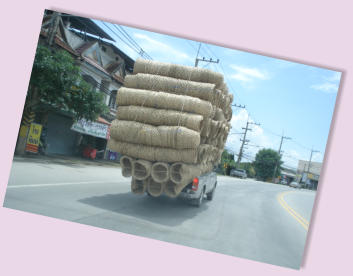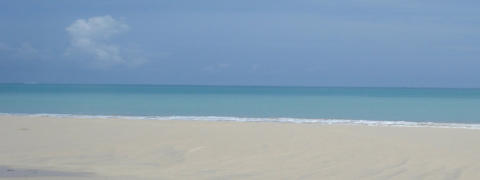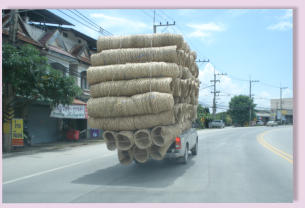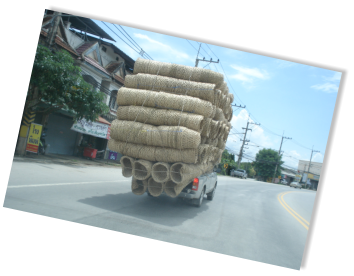
Thailand Day to Day
Driving in Thailand
Driving in Thailand is not the terrifying experience one is led to believe in
some travel guides, especially if you venture out away from the cities.
Driving is on the left, unless you are on a motorcycle where bi-directional
travel adjacent to the sidewalk is accepted in some areas out of the cities.
This is, of course, both sides of the road.
You can turn left at a red traffic light when it is safe to do so, but only left.
Apart from that, no more is necessary than the concentration required on
driving safely that you would use at home.
You won’t find a self service fuel station but you will get a smile from the
pump attendant. It would not be customary to tip them though. Most fuel
stations have good facilities by way of toilets and a shop. In the major
towns, fuel stations may have a coffee shop and a restaurant too.
Tuk Tuk and Taxi Travel
Tuk Tuks are three-wheeled, open sided scooters and a great way to get
around Bangkok and other cities.
Always fix the rate before the journey if you can but most journeys will be
less than 150 Baht.
A taxi will be a little more but again check the rate before travel. A meter taxi
is always better than one without.
Drivers of both modes of transport may try to persuade you that they know a
good place to buy a suit or that a 24 carat store is a great place for a detour.
This is all part of taxi travel culture and the drivers may get a commission
from the store for taking you there (usually a few litres of fuel). The 24 carat
shop is filled with expensive jewellery and you get a tour of the factory to see
how they are made. If you do not want to buy expensive jewellery, it is still
worth a visit to see them and there is usually a section in the shop with some
very good value quality souvenirs at economical prices. Just allow plenty of
time and join in the fun.
Haggling
Thais generally expect some negotiation from tourist buyers and you can
obtain a good discount if buying more than one item. Shops rarely discount
other than the already discounted price and also food market stalls generally
do not.
Other market stalls in tourist areas will discount, jewellery and suit shops will
to some extent too.
So it is always worth a try and can be a bit of fun too. Use 50 per cent as a
starting point and usually that will be returned with a smile and the offer of a
discount for buying more than one. Great for T shirts but not much use for a
wedding ring.
You will know when you are getting near the agreed price as the vendor may
say in Thai tham mai dai. This means ‘cannot’. If you say dai back and the
price does not come down further, then that is probably the lowest price you
will get. You could try walking away and going back but anything further will
depend on whether the vendor is desperate to get a sale.
Always smile when haggling as it is good manners.
The Wai
The Wai is an essential part of Thai culture and is used as a mark of respect.
It is a greeting used for both hello and goodbye. The name Wai is a fairly
recent designation but the tradition goes back thousands of years.
The Wai is carried out by placing of palms together, putting hands with fingers
at the tip of the nose and bowing slightly. As we say, it is a mark of respect so
there are other ways of Wai-ing and this depends on your social status, the
higher status meaning a lower bow too. For everyday use the mentioned
method will be fine.
The lower social status will Wai first. This also means the younger person.
It is considered inappropriate not to acknowledge a Wai, so Wai back or bow
your head if your hands are occupied.
It is not customary to Wai if you are paying for services, for instance a
shopkeeper or Taxi driver. If they Wai to you, again just bow your head.
However, if they do more than serve you, by giving directions or take care of
the children in the shop, then it is perfectly acceptable to thank them with a
Wai as you leave, again a show of respect.
Some more Day to Day coming soon.

Thailand Genius
For Everything Thailand
Copyright © 2014-2015 ThailandGenius.com. All Rights Reserved




Thailand Day to Day
Driving in Thailand
Driving in Thailand is not the terrifying experience one is led
to believe in some travel guides, especially if you venture out
away from the cities.
Driving is on the
left, unless you
are on a
motorcycle where
bi-directional
travel adjacent to
the sidewalk is
accepted in some
areas out of the
cities. This is, of
course, both
sides of the road.
You can turn left at a red traffic light when it is safe to do so,
but only left.
Apart from that, no more is necessary than the concentration
required on driving safely that you would use at home.
You won’t find a self service fuel station but you will get a
smile from the pump attendant. It would not be customary
to tip them though. Most fuel stations have good facilities by
way of toilets and a shop. In the major towns, fuel stations
may have a coffee shop and a restaurant too.
Tuk Tuk and Taxi Travel
Tuk Tuks are three-wheeled, open sided scooters and a great
way to get around Bangkok and other cities.
Always fix the rate before the journey if you can but most
journeys will be less than 150 Baht.
A taxi will be a little more but again check the rate before
travel. A meter taxi is always better than one without.
Drivers of both modes of transport may try to persuade you
that they know a good place to buy a suit or that a 24 carat
store is a great place for a detour.
This is all part of taxi travel culture and the drivers may get
a commission from the store for taking you there (usually a
few litres of fuel). The 24 carat shop is filled with expensive
jewellery and you get a tour of the factory to see how they
are made. If you do not want to buy expensive jewellery, it is
still worth a visit to see them and there is usually a section in
the shop with some very good value quality souvenirs at
economical prices. Just allow plenty of time and join in the
fun.
Haggling
Thais generally expect some negotiation from tourist buyers
and you can obtain a good discount if buying more than one
item. Shops rarely discount other than the already
discounted price and also food market stalls generally do
not.
Other market stalls in tourist areas will discount, jewellery
and suit shops will to some extent too.
So it is always worth a try and can be a bit of fun too. Use
50 per cent as a starting point and usually that will be
returned with a smile and the offer of a discount for buying
more than one. Great for T shirts but not much use for a
wedding ring.
You will know when you are getting near the agreed price as
the vendor may say in Thai tham mai dai. This means
‘cannot’. If you say dai back and the price does not come
down further, then that is probably the lowest price you will
get. You could try walking away and going back but anything
further will depend on whether the vendor is desperate to
get a sale.
Always smile when haggling as it is good manners.
The Wai
The Wai is an essential part of Thai culture and is used as a
mark of respect. It is a greeting used for both hello and
goodbye. The name Wai is a fairly recent designation but the
tradition goes back thousands of years.
The Wai is carried out by placing of palms together, putting
hands with fingers at the tip of the nose and bowing slightly.
As we say, it is a mark of respect so there are other ways of
Wai-ing and this depends on your social status, the higher
status meaning a lower bow too. For everyday use the
mentioned method will be fine.
The lower social status will Wai first. This also means the
younger person.
It is considered inappropriate not to acknowledge a Wai, so
Wai back or bow your head if your hands are occupied.
It is not customary to Wai if you are paying for services, for
instance a shopkeeper or Taxi driver. If they Wai to you,
again just bow your head. However, if they do more than
serve you, by giving directions or take care of the children in
the shop, then it is perfectly acceptable to thank them with a
Wai as you leave, again a show of respect.
Some more Day to Day coming soon.



- Home
- Travel
- Locations
- North Thailand
- Useful Tips
- Thai Phrases
- Thai Food
- Thai Ingredients
- Thai Food Recipes
- Thai Green Curry
- Thai Red Curry
- Oyster Chicken with Herbs
- Massaman Curry
- Sweet Chilli Chicken
- Thai Language
- Language Introduction
- Thai Flashcards
- Online Learning
- Day to Day
- Contact Us
- Privacy Policy
Thailand Genius
For Everything Thailand
Copyright © 2014-2015 ThailandGenius.com. All
Rights Reserved




Thailand Day to Day
Driving in Thailand
Driving in Thailand is not the terrifying experience
one is led to believe in some travel guides, especially
if you venture out away from the cities.
Driving is on the left, unless you are on a
motorcycle where bi-directional travel adjacent to
the sidewalk is accepted in some areas out of the
cities. This is, of course, both sides of the road.
You can turn left at a red traffic light when it is
safe to do so, but only left.
Apart from that, no more is necessary than the
concentration required on driving safely that you would use at home.
You won’t find a self service fuel station but you will get a smile from the
pump attendant. It would not be customary to tip them though. Most fuel
stations have good facilities by way of toilets and a shop. In the major towns,
fuel stations may have a coffee shop and a restaurant too.
Tuk Tuk and Taxi Travel
Tuk Tuks are three-wheeled, open sided scooters and a great way to get
around Bangkok and other cities.
Always fix the rate before the journey if you can but most journeys will be
less than 150 Baht.
A taxi will be a little more but again check the rate before travel. A meter taxi
is always better than one without.
Drivers of both modes of transport may try to persuade you that they know a
good place to buy a suit or that a 24 carat store is a great place for a detour.
This is all part of taxi travel culture and the drivers may get a commission
from the store for taking you there (usually a few litres of fuel). The 24 carat
shop is filled with expensive jewellery and you get a tour of the factory to see
how they are made. If you do not want to buy expensive jewellery, it is still
worth a visit to see them and there is usually a section in the shop with some
very good value quality souvenirs at economical prices. Just allow plenty of
time and join in the fun.
Haggling
Thais generally expect some negotiation from tourist buyers and you can
obtain a good discount if buying more than one item. Shops rarely discount
other than the already discounted price and also food market stalls generally
do not.
Other market stalls in tourist areas will discount, jewellery and suit shops will
to some extent too.
So it is always worth a try and can be a bit of fun too. Use 50 per cent as a
starting point and usually that will be returned with a smile and the offer of a
discount for buying more than one. Great for T shirts but not much use for a
wedding ring.
You will know when you are getting near the agreed price as the vendor may
say in Thai tham mai dai. This means ‘cannot’. If you say dai back and the
price does not come down further, then that is probably the lowest price you
will get. You could try walking away and going back but anything further will
depend on whether the vendor is desperate to get a sale.
Always smile when haggling as it is good manners.
The Wai
The Wai is an essential part of Thai culture and is used as a mark of respect.
It is a greeting used for both hello and goodbye. The name Wai is a fairly
recent designation but the tradition goes back thousands of years.
The Wai is carried out by placing of palms together, putting hands with fingers
at the tip of the nose and bowing slightly. As we say, it is a mark of respect so
there are other ways of Wai-ing and this depends on your social status, the
higher status meaning a lower bow too. For everyday use the mentioned
method will be fine.
The lower social status will Wai first. This also means the younger person.
It is considered inappropriate not to acknowledge a Wai, so Wai back or bow
your head if your hands are occupied.
It is not customary to Wai if you are paying for services, for instance a
shopkeeper or Taxi driver. If they Wai to you, again just bow your head.
However, if they do more than serve you, by giving directions or take care of
the children in the shop, then it is perfectly acceptable to thank them with a
Wai as you leave, again a show of respect.
Some more Day to Day coming soon.

Thailand Genius
For Everything Thailand
Copyright © 2014-2015 ThailandGenius.com. All Rights Reserved


































